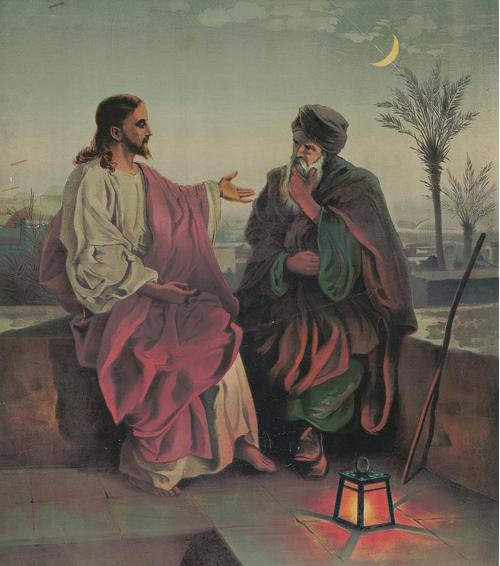Lesson 1

Born Again: The Transformative Encounter Between Nicodemus and Jesus
Introduction
Have you ever approached a familiar Bible passage thinking, 'I already know this story'? That was my initial thought with John chapter 3—this familiar territory of Nicodemus and Jesus, crowned by the most memorized verse in Scripture. But the Holy Spirit convicted me: before us lies not just another passage, but the central truth around which all of Scripture orbits. We aren't going to merely skim the surface today; we're diving deep into the ocean of divine truth about spiritual rebirth. As Catholics, we recognize that this encounter between Nicodemus and Jesus lays the foundation for our understanding of Baptism and sacramental life. My prayer is that even those who have studied this passage countless times will experience these eternal truths with renewed wonder and fresh perspective, seeing how they illuminate our Catholic faith and practice.
The Man Who Had Everything
"Now there was a man of the Pharisees named Nicodemus, a ruler of the Jews." With this simple introduction, John presents a man of extraordinary credentials.
First, Nicodemus possessed religious passion as a Pharisee. The Pharisees—never more than 6,000 strong—were the kabora, the brotherhood. While often remembered for their legalism, they were also people of extraordinary commitment. They dedicated their entire lives to keeping every minute detail of both biblical and scribal law. They developed thousands of regulations interpreting Scripture's commands—defining exactly what constituted 'work' on the Sabbath down to the weight of objects one could lift or the types of knots one could tie. While we might find such legalism absurd, we must acknowledge their passionate commitment to what they believed would please God. Perhaps we, enjoying grace and freedom, should question how passionately we pursue obedience to Christ in our own lives.
Second, Nicodemus was a man of wealth and social prominence. Rabbinical tradition names his family among Jerusalem's three wealthiest. His Greek name suggests an upper-class upbringing with access to Greek tutors—the equivalent of an Eisenhower or Rockefeller of his day.
Third, he was 'a ruler of the Jews'—a member of the Sanhedrin, the supreme court of Israel consisting of 71 religious leaders who determined Israel's policies and examined prophetic claims. These were the most influential men in Jewish society.
Finally, as Jesus later addresses him as 'the teacher of Israel' (v.10), we understand Nicodemus was renowned for his scriptural knowledge. He knew the facts of Scripture, though as we'll discover, he had missed its transformative truth.
Here stands the epitome of human achievement—educated, religious, influential, and respected. If anyone could earn their way into heaven by human credentials, it would be Nicodemus. Yet, as we'll see, he remained spiritually lost.
A Midnight Conversation That Changed History
"This man came to Jesus by night" (v.2). Whether out of fear or following the rabbinic tradition that night was the best time to study Torah, Nicodemus approaches Jesus with respect: "Rabbi, we know that you are a teacher come from God, for no one can do these signs that you do unless God is with him."
This polite introduction essentially asks: "If you truly come from God with divine authority, what is your primary message?"
Jesus's response is both shocking and direct: "Truly, truly, I say to you, unless one is born again, he cannot see the kingdom of God" (v.3).
As Catholics, we understand this statement in light of the Church's teaching on Baptism. The Catechism of the Council of Trent instructs us that "The faithful are to be taught that this wonderful effect of Baptism is produced by virtue of the Passion of our Lord," and that through this sacrament, we experience "a spiritual regeneration, by which we are born children of God." What Jesus is revealing to Nicodemus is the necessity of sacramental regeneration, which the Church has understood and taught since apostolic times.
Confused, Nicodemus asks the logical question: "How can a man be born when he is old? Can he enter a second time into his mother's womb and be born?" (v.4).
Three Divine Illustrations of Spiritual Rebirth
Jesus responds with three powerful illustrations that explain the mystery of spiritual rebirth, each with profound significance for our Catholic understanding of the sacraments and spiritual life.
First, Jesus uses physical birth as an analogy: "Truly, truly, I say to you, unless one is born of water and the Spirit, he cannot enter the kingdom of God. That which is born of the flesh is flesh, and that which is born of the Spirit is spirit" (vv.5-6).
The Church Fathers, including St. Augustine and St. Ambrose, consistently interpreted this passage as referring to Baptism. The Catechism of the Council of Trent affirms this interpretation, teaching that "Our Lord, speaking of Baptism in the Gospel, says: 'Unless a man be born again of water and the Holy Ghost, he cannot enter into the kingdom of God,' and the Apostle, writing to the Ephesians, says: 'Christ loved the Church, and delivered himself up for it; that he might sanctify it, cleansing it by the laver of water in the word of life.'" This sacrament is not merely symbolic but effects what it signifies—true spiritual rebirth. Through the waters of Baptism, we are incorporated into Christ and his Church, receiving sanctifying grace and the indwelling of the Holy Spirit.
Second, Jesus illustrates with the wind: "The wind blows where it wishes, and you hear its sound, but you do not know where it comes from or where it goes. So it is with everyone who is born of the Spirit" (v.8).
This beautiful analogy reminds us that while the sacraments employ visible signs, their effects are invisible yet real and transformative. As the Tridentine Catechism teaches regarding Baptism: "Although the work accomplished in the sacrament is not perceptible to the senses, yet it consists in the spiritual regeneration of the soul, which cannot be seen." We cannot see grace itself, but we witness its effects in the transformed lives of the faithful. The Holy Spirit works through the sacramental economy of the Church to sanctify us, often in ways beyond our understanding or perception.
Third, Jesus provides his clearest illustration through the bronze serpent: "And as Moses lifted up the serpent in the wilderness, so must the Son of Man be lifted up, that whoever believes in him may have eternal life" (vv.14-15).
This prefigures Christ's sacrifice on the cross, which is re-presented in an unbloody manner in every celebration of the Eucharist. The Catechism of the Council of Trent explains that "The Eucharist was instituted by Christ for two principal purposes: one, that it might be the heavenly food of our souls, by which we may be supported and strengthened during the journey of this life; the other, that the Church might have a perpetual sacrifice, by which our sins might be expiated, and our heavenly Father, oftentimes grievously offended by our crimes, might be turned away from wrath to mercy, from the severity of just punishment to clemency." Just as the Israelites were healed by looking upon the bronze serpent, we receive spiritual healing and nourishment by faithfully participating in the Eucharistic celebration.
The connection between these three illustrations reveals the sacramental nature of God's plan for our salvation—using visible signs to convey invisible grace, working through material creation to effect spiritual transformation.
The Living Waters of Sacramental Grace
Imagine discovering an old, rundown farmyard with a well and pump. Dying of thirst, you frantically work the rusty handle, but nothing comes out—the well is dry.
What has mankind done throughout history? We've focused on making the pump look better. We've painted it, replaced the handle with brass, sung songs about it, and admired its appearance. People come from all around to see this attractive pump, but it will never produce a single drop of water.
Nicodemus, with all his credentials, was like that beautiful pump—respected, admired, sought after for wisdom. But without spiritual rebirth, he could only produce dust and dry air. He needed to encounter the well of living water in Jesus Christ.
As Catholics, we recognize that Christ established his Church to be the ongoing source of these living waters. Through the seven sacraments, especially Baptism and the Eucharist, Christ continues to pour out his grace upon us. The Catechism of the Council of Trent teaches that Baptism "washes away the stains of sin, and makes us the adopted children of God." It further explains that the Eucharist "contains Christ our Lord, the true grace and the source of all heavenly gifts."
The Tridentine Catechism also instructs that "the grace of Baptism is so powerful as to remit original sin and actual guilt, however unthinkable its enormity may seem." This is precisely what Jesus was teaching Nicodemus—that external religious observance, no matter how perfect, cannot replace the interior transformation that comes through sacramental grace.
The Son of Man descended from heaven to earth so that we might ascend from earth to heaven. The foot of the cross touches earth, declaring that God has moved to touch humanity. The top points heavenward, showing the way home. And the outstretched arms proclaim "whosoever will may come"—even you, even me. This is the mystery we celebrate in every Mass, where heaven touches earth and we are invited to participate in divine life.
Conclusion
The gospel's most profound truth is this: no matter our achievements, credentials, or religious devotion, we all need spiritual rebirth through the waters of Baptism and ongoing nourishment through the sacramental life of the Church. Nicodemus—the epitome of human achievement—needed it. And so do we.
The Catechism of the Council of Trent reminds us that the sacraments are "sensible signs which, by divine institution, not only signify, but also impart holiness and justice." This is the heart of what Jesus was teaching Nicodemus—that God has established ordinary means by which extraordinary grace is conveyed.
Tradition tells us that Nicodemus eventually embraced this truth. The Gospel of John records that he later helped prepare Jesus' body for burial (John 19:39), and Church tradition holds that he was baptized by Peter and John, became a faithful disciple, and was eventually martyred for his faith. From curious inquirer to baptized believer to martyr—this is the transformative journey made possible by sacramental grace.
As we conclude, I invite you to consider: Have you fully embraced the sacramental life Christ offers through his Church? Are you regularly participating in the Eucharist and Reconciliation? Are you allowing these sacred mysteries to transform you from within?
Remember that Jesus didn't come merely to teach us new doctrines but to make us new creations through the sacramental life of his Church. As St. Paul writes, "If anyone is in Christ, he is a new creation. The old has passed away; behold, the new has come" (2 Corinthians 5:17).
Let us pray that like Nicodemus, we might move from curious inquiry to genuine faith—from religious achievement to spiritual rebirth through the sacraments Christ has entrusted to his Church.


